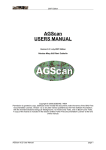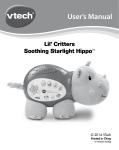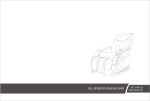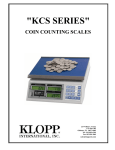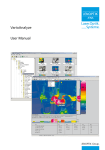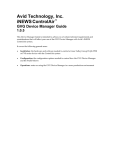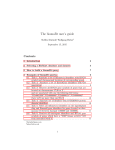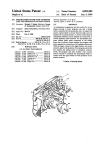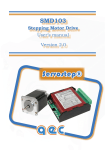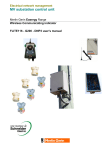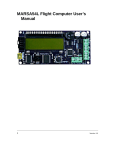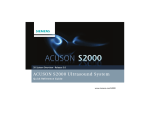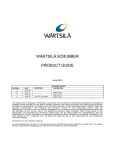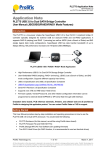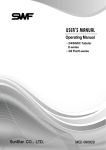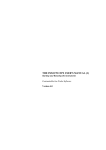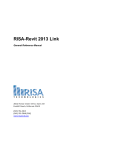Download Using AGScan - MulCyber
Transcript
Sigenae
July 2007 Edition
MAI_simulator
Micro Array Image Simulator
USERS MANUAL
Version 0.5 / July 2007 Edition
Nicolas Mary & Christophe Klopp
Copyright © 2007 SIGENAE / INRA
Permission is granted to copy, distribute and/or modify this document under the terms of the GNU Free
Documentation License, Version 1.2 or any later version published by the Free Software Foundation;
with the Invariant Sections being just "Background", no Front-Cover Texts, and no Back-Cover Texts. A
copy of the license is included in the section entitled "GNU Free Documentation License" at the end of
this manual.
MAI Simulator v0.5 User Manual
page 1
Sigenae
July 2007 Edition
Revision table :
Version
Date
th
Major modifications
Author(s)
0.1
June 6 2007
First draft
N. Mary
0.2
June 27th 2007
First revision
Ch. Klopp
Second revision
N. Mary
th
0.3
June 27 2007
0.4
th
July 11 2007
Third revision
Ch. Klopp
0.5
July 11th 2007
Fourth revision
N. Mary
Acknowledgment :
I wrote this guide in English having the aim to give access to MAI_simulator to the largest
possible scientific community. But English is not my mother language, so any remark about
the orthography or the grammar is welcome.
MAI Simulator v0.5 User Manual
page 2
Sigenae
July 2007 Edition
INDEX
I. INTRODUCTION ...............................................................................................................................................5
II. PARAMETER SETTING...................................................................................................................................6
1.GENERAL ..............................................................................................................................................................6
2.GRID ....................................................................................................................................................................8
1.Grid dimensions.............................................................................................................................................8
2.Grid noises.....................................................................................................................................................9
3.SPOT ..................................................................................................................................................................10
1.General........................................................................................................................................................10
2.Spot noises....................................................................................................................................................11
4.NOISE .................................................................................................................................................................12
1.General noise...............................................................................................................................................12
2.Local noise (Not implemented in the July 2007 version)............................................................................12
3.Scratch & dust noise....................................................................................................................................12
5.SPIKES ................................................................................................................................................................13
6.FASTVIEW ...........................................................................................................................................................14
7.RESULT FILE ........................................................................................................................................................15
III. NOISES AND RANDOM VALUES................................................................................................................16
1.MEAN VALUE AND STANDARD DEVIATION....................................................................................................................16
2.SPOT REPARTITION.................................................................................................................................................16
GNU GENERAL PUBLIC LICENSE.................................................................................................................19
MAI Simulator v0.5 User Manual
page 3
Sigenae
July 2007 Edition
Illustration Index
Illustration
Illustration
Illustration
Illustration
Illustration
Illustration
Illustration
Illustration
Illustration
Illustration
Illustration
Illustration
Illustration
Illustration
1: Tabbed Menu............................................................................................ ......5
2: Progress bar and launch button......................................................... .............5
3: General parameters............................................................ ...........................6
4: Border size......................................................................................... ............7
5: Grid parameters.............................................................................. ...............8
6: Spot parameters........................................................... ...............................10
7: Noise parameters.......................................................................... ...............12
8: Spikes................................................................................... .......................13
9: Fast view........................................................................................ ..............14
10: Quantification file example 1.............................................................. ........15
11: Quantification file example 2.............................................................. ........15
12: Gaussian curve......................................................................................... ..16
13: Shape repartition before....................................................................... ......17
14: Shape repartition after...................................................... .........................18
MAI_simulator Plugin User Manual
page 4/20
Sigenae
July 2007 Edition
I. Introduction
Micro Array Image Simulator (MAI_simulator) has been developed in order to generate micro array
images. These images are simulated thanks to several user defined parameters. Generating these
images aims at creating test sets for image quantification software. For each run the simulator generates
sets of images and the corresponding quantification files. These quantification files can be used as
references while analyzing and comparing microarray image quantification software.
Parameters are sorted in five categories :
– General parameters
– Grid parameters
– Spot parameters
– Noise parameters
– Spike-ins
General parameters define the naming schema of the created files and the directory in which the file are
generated. The grid parameters define the grid configuration elements such as number of meta rows,
meta columns, rows and columns. The spot parameters determine the spot shape, expression level ,
saturations and deformation. In order to stick to real data users are able to add different kinds of noises
thanks to noise parameters. The spike-ins tab enables the user to define the location of saturated spots
in the image. The spots can be used in the grid positioning process or in quantification normalization
process.
When all parameters fields are set, the user can launch the process and then take a look at the
generated images and quantification files.
Tabbed menu
Illustration 1: Tabbed Menu
The launch button “Validate” and the progress bar are located at the bottom of the pane.
Illustration 2: Progress bar and launch button
MAI_simulator Plugin User Manual
page 5/20
Sigenae
July 2007 Edition
II. Parameter Setting
The chapter explains how to set the different parameter fields before launching the
process.
1. General
Illustration 3: General parameters
The general tab enables to specify :
●
Working directory
This is the directory where all output files will be saved.
●
Number of channels
The number of channels of your experiments (between 1 and **)
●
Number of images
The number of experiments you want to generate (between 1 and **)
●
Base name
All images and quantification files names will start with the base name. For
example, if you choose a 3-channels, 2 images experiment with “Test” as base
name, output files will be :
-Test1_1.tiff, Test1_2.tiff, Test1_3.tiff (the 3 channels of the first
image)
MAI_simulator Plugin User Manual
page 6/20
Sigenae
July 2007 Edition
-Test2_1.tiff, Test2_2.tiff, Test2_3.tiff (the 3 channels of the
second image)
-Test1.txt (the quantification file for the first image)
-Test2.txt (the quantification file for the second image)
●
Border size (in pixels)
You can set the size of the image borders.
Illustration 4: Border size
NB : Be careful when defining the border size for rotated images.
MAI_simulator Plugin User Manual
page 7/20
Sigenae
July 2007 Edition
2. Grid
Illustration 5: Grid parameters
1. Grid dimensions
●
●
●
●
●
●
●
●
●
Number of lines
This is the number of block lines.
Number of columns
This is the number of block columns.
Number of meta-lines
This is the number of lines in one block.
Number of meta-columns
This is the number of columns in one block.
Space inter-lines (in pixels)
This is the gap between block lines.
Space inter-columns (in pixels)
This is the gap between block columns.
Space inter-meta-lines (in pixels)
This is the gap between lines in each block.
Space inter-meta-columns (in pixels)
This is the gap between columns in each block.
Pixel size (in µ-meters)
This is the pixel height and width.
MAI_simulator Plugin User Manual
page 8/20
Sigenae
July 2007 Edition
2. Grid noises
For not perfectly regular grids it is possible to introduce three kinds of noise :
Angle (in degrees)
Rotates the grid.
● Enlargement (in pixels)
Enlarge the grid length.
● Block shift (in pixels)
Make a random shift on the grid blocks. You must give two values for each
shift side (horizontal and vertical) : the mean and the standard deviation. More
explanations are given in the “Noises and random” chapter.
●
MAI_simulator Plugin User Manual
page 9/20
Sigenae
July 2007 Edition
3. Spot
Illustration 6: Spot parameters
1. General
Once grid parameters have been set, you have to decide what you want the
spots to look like.
●
●
●
●
●
Expression rate (%)
Sets the rate of expressed spots.
Saturation rate (%)
Sets the rate of saturated spots.
Deformation rate (%)
Sets the rate of distorted spots.
Shape repartition (%)
Here, you will choose a percentage for each shape model. The total must be
100 unless the process can't be launched.
Spot size (in pixels)
You must also set the spot width and height.
MAI_simulator Plugin User Manual
page 10/20
Sigenae
July 2007 Edition
2. Spot noises
Spot shift (in pixels)
Make a random shift on spots. You must give two values : the mean and the
standard deviation. More explanations are given in the “Noises and random”
chapter.
● Inter-channel shift (in pixels)
In mono-channel case, this has no effect. In multi-channel case, this noise is
not applied to the first channel image but to all others.
Make a random shift on the whole channel image. You just give one value here
: the standard deviation. In fact, the mean is set to 0. More explanations are
given in the “Noises and random” chapter.
●
MAI_simulator Plugin User Manual
page 11/20
Sigenae
July 2007 Edition
4. Noise
Illustration 7: Noise parameters
1. General noise
Here you can set a background noise value. This will add a “salt and pepper”
noise all over the images. The value sets the noise density : a high value
means a high density.
2. Local noise (Not implemented in the July 2007 version)
Local noise refers to fractal phenomenas. If you want to add this kind of noise,
you must choose the number of fractals and their size. During the process,
fractals will be placed randomly on the images.
3. Scratch & dust noise
You can also put scratch and dust noises on your images. These aim to
simulate the micro-dusts on the glass slides. You could choose two
shapes : ovals and/or lines, and how much of each you want. Then you must
customize them specifying their width and height. Like with local noise,
scratches and dusts will be placed randomly on the images.
MAI_simulator Plugin User Manual
page 12/20
Sigenae
July 2007 Edition
5. Spikes
Illustration 8: Spikes
Spikes are spots set to the maximum intensity value. In fact, they are used to indicate a
position on the grid, like tags. They are very helpful in the alignment process.
For example, they can be used to locate the upper-left corner of each block of the grid.
You can specify a list of spikes giving their coordinates with the following format :
i,j,k,l:c1{,c2,c3,...}
{...} means optional
i is the line index of the block
j is the column index of the block
k is the line index of the spot in the block
l is the column index of the spot in the block
c1,c2,c3 are the channel indexes, you must give one at least
MAI_simulator Plugin User Manual
page 13/20
Sigenae
July 2007 Edition
6. Fastview
When MAI_Simulator has ended producing the tif files (16bits , one file per channel), the
user can visualize the upper left corner of the generated images using the fast view panel.
He can choose the image he wants to check in the drop-down list.
Illustration 9: Fast view
MAI_simulator Plugin User Manual
page 14/20
Sigenae
July 2007 Edition
7. Result file
MAI_Simulator generates images on one side and quantification files on the other. The
quantification files contain the random channel intensities for each channel of the image.
The examples presented hereunder correspond to single and a four channel images.
These files have several columns :
•
Index : spot index
•
X and Y location in micro meters of the spot center on image,
•
R, C, MR, MC : bloc row, bloc column, spot row and spot column within the bloc,
•
ChanX : X channel intensity
The result file is used to evaluate the quantification accuracy of microarray image
analysis tools.
Illustration 10: Quantification file example 1
Illustration 11: Quantification file example 2
MAI_simulator Plugin User Manual
page 15/20
Sigenae
July 2007 Edition
III. Noises and random values
Random number generation is very useful to produce a realistic set of images. Nearly all
kinds of noise have a random part. This chapter explains how random is used in
MAI_Simulator.
DNA chips images are known to contain many kinds of noise :
Noise in experiment chain
Noise in MAISimulator
Systematic position errors because of pin deformations. Block shift noise
Non systematic position error
Spot shift noise
Orientation variation
Angle noise
Deformation of the initial spotting schema due to soft
support material (membrane technology)
Enlargement noise
Background noise due to quality of scan
General and local noises
Background noise due to dusts
Scratch and dust noise
1. Mean value and standard deviation
Some random values are generated using the Gaussian distribution. This is why, often you
have to give two values in the user interface of MAI_Simulator : the mean value and the
standard deviation.
Illustration 12: Gaussian curve
The values are taken between (Mean - 3*Sd) and (Mean + 3*Sd).
For example, if you give a mean value of 2.0 and a standard deviation of 1.0, the random
values could be between -1.0 and 5.0 but in most of cases they will be between 1.0 and
3.0.
2. Spot repartition
The spot positioning in image uses a random system too. In fact, you give the system the
percentage you want for each spot shape, then according to the total number of spots and
these percentages the software computes how much spots of each shape are needed. For
each spot, it chooses the shape at random and re-samples if the quantity needed has been
MAI_simulator Plugin User Manual
page 16/20
Sigenae
July 2007 Edition
reached. Finally, you obtain exactly the percentages you have specified but the space
repartition over images is randomly designed.
Adding spot shapes
Three shape models have been developed in this Plugin : Circle, Gaussian and Donut.
MAI_Simulator was designed in order to allow developers to easily add new ones without
changing the code.
Each shape model implements an interface class : the Spot class. Examples can be found
using the CircleSpot, GaussianSpot and DonutSpot classes.
All the class names end with “Spot” and this is used by MAI_Simulator to load them. So if
someone wants to develop a new shape model, she or he has to create a new class named
“ShapeNameSpot” derived from Spot. After that two abstract methods getImageSpot and
deformate must be implemented.
Then the java file must be compiled and the class file put in the “/plugins” directory of
your ImageJ install.
Finally, the MAIS_parameters.properties file must be updated by adding a new spot
shape name to the shapes line :
shapes=Circle,Gaussian,Donut,ShapeName
where ShapeName is the new shape model.
If a model is to be removed just remove its name from the list.
Example removing the Circle shape :
shapes=Gaussian,Donut,ShapeName
The user interface evolves with the shape names provided in the shapes line of the
MAIS_parameters.properties file.
User interface before :
Illustration 13: Shape repartition before
MAI_simulator Plugin User Manual
page 17/20
Sigenae
July 2007 Edition
User interface after adding Custom and Donought shapes:
Illustration 14: Shape repartition after
MAI_simulator Plugin User Manual
page 18/20
Sigenae
July 2007 Edition
GNU GENERAL PUBLIC LICENSE
Version 2, June 1991
Copyright (C) 1989, 1991 Free Software Foundation, Inc.
51 Franklin St, Fifth Floor, Boston, MA 02110-1301, USA
Everyone is permitted to copy and distribute verbatim copies
of this license document, but changing it is not allowed.
Preamble
The licenses for most software are designed to take away your freedom to share and change it. By contrast, the GNU General Public License is intended to
guarantee your freedom to share and change free software--to make sure the software is free for all its users. This General Public License applies to most of
the Free Software Foundation's software and to any other program whose authors commit to using it. (Some other Free Software Foundation software is
covered by the GNU Library General Public License instead.) You can apply it to your programs, too.
When we speak of free software, we are referring to freedom, not price. Our General Public Licenses are designed to make sure that you have the freedom to
distribute copies of free software (and charge for this service if you wish), that you receive source code or can get it if you want it, that you can change the
software or use pieces of it in new free programs; and that you know you can do these things.
To protect your rights, we need to make restrictions that forbid anyone to deny you these rights or to ask you to surrender the rights. These restrictions
translate to certain responsibilities for you if you distribute copies of the software, or if you modify it.
For example, if you distribute copies of such a program, whether gratis or for a fee, you must give the recipients all the rights that you have. You must make
sure that they, too, receive or can get the source code. And you must show them these terms so they know their rights.
We protect your rights with two steps: (1) copyright the software, and (2) offer you this license which gives you legal permission to copy, distribute and/or
modify the software.
Also, for each author's protection and ours, we want to make certain that everyone understands that there is no warranty for this free software. If the
software is modified by someone else and passed on, we want its recipients to know that what they have is not the original, so that any problems introduced
by others will not reflect on the original authors' reputations.
Finally, any free program is threatened constantly by software patents. We wish to avoid the danger that redistributors of a free program will individually
obtain patent licenses, in effect making the program proprietary. To prevent this, we have made it clear that any patent must be licensed for everyone's free
use or not licensed at all.
The precise terms and conditions for copying, distribution and modification follow.
TERMS AND CONDITIONS FOR COPYING, DISTRIBUTION AND MODIFICATION
0. This License applies to any program or other work which contains a notice placed by the copyright holder saying it may be distributed under the terms of this General Public
License. The "Program", below, refers to any such program or work, and a "work based on the Program" means either the Program or any derivative work under copyright law:
that is to say, a work containing the Program or a portion of it, either verbatim or with modifications and/or translated into another language. (Hereinafter, translation is included
without limitation in the term "modification".) Each licensee is addressed as "you".
Activities other than copying, distribution and modification are not covered by this License; they are outside its scope. The act of running the Program is not restricted, and the
output from the Program is covered only if its contents constitute a work based on the Program (independent of having been made by running the Program). Whether that is true
depends on what the Program does.
1. You may copy and distribute verbatim copies of the Program's source code as you receive it, in any medium, provided that you conspicuously and appropriately publish on
each copy an appropriate copyrig ht notice and disclaimer of warranty; keep intact all the notices that refer to this License and to the absence of any warranty; and give any other
recipients of the Program a copy of this License along with the Program.
You may charge a fee for the physical act of transferring a copy, and you may at your option offer warranty protection in exchange for a fee.
2. You may modify your copy or copies of the Program or any portion of it, thus forming a work based on the Program, and copy and distribute such modifications or work under
the terms of Section 1 above, provided that you also meet all of these conditions:
a) You must cause the modified files to carry prominent notices stating that you changed the files and the date of any change.
b) You must cause any work that you distribute or publish, that in whole or in part contains or is derived from the Program or any part thereof, to be licensed as a
whole at no charge to all third parties under the terms of this License.
c) If the modified program normally reads commands interactively when run, you must cause it, when started running for such interactive use in the most ordinary
way, to print or display an announcement including an appropriate copyright notice and a notice that there is no warranty (or else, saying that you provide a warranty)
and that users may redistribute the program under these conditions, and telling the user how to view a copy of this License. (Exception: if the Program itself is
interactive but does not normally print such an announcement, your work based on the Program is not required to print an announcement.)
These requirements apply to the modified work as a whole. If identifiable sections of that work are not derived from the Program, and can be reasonably considered independent
and separate works in themselves, then this License, and its terms, do not apply to those sections when you distribute them as separate works. But when you distribute the same
sections as part of a whole which is a work based on the Program, the distribution of the whole must be on the terms of this License, whose permissions for other licensees extend
to the entire whole, and thus to each and every part regardless of who wrote it.
Thus, it is not the intent of this section to claim rights or contest your rights to work written entirely by you; rather, the intent is to exercise the right to control the distribution of
derivative or collective works based on the Program.
In addition, mere aggregation of another work not based on the Program with the Program (or with a work based on the Program) on a volume of a storage or distribution medium
does not bring the other work under the scope of this License.
3. You may copy and distribute the Program (or a work based on it, under Section 2) in object code or executable form under the terms of Sections 1 and 2 above provided that
you also do one of the following:
a) Accompany it with the complete corresponding machine-readable source code, which must be distributed under the terms of Sections 1 and 2 above on a medium
customarily used for software interchange; or,
b) Accompany it with a written offer, valid for at least three years, to give any third party, for a charge no more than your cost of physically performing source
distribution, a complete machine-readable copy of the corresponding source code, to be distributed under the terms of Sections 1 and 2 above on a medium
customarily used for software interchange; or,
c) Accompany it with the information you received as to the offer to distribute corresponding source code. (This alternative is allowed only for noncommercial
distribution and only if you received the program in object code or executable form with such an offer, in accord with Subsection b above.)
The source code for a work means the preferred form of the work for making modifications to it. For an executable work, complete source code means all the source code for all
modules it contains, plus any associated interface definition files, plus the scripts used to control compilation and installation of the executable. However, as a special exception,
the source code distributed need not include anything that is normally distributed (in either source or binary form) with the major components (compiler, kernel, and so on) of the
operating system on which the executable runs, unless that component itself accompanies the executable.
If distribution of executable or object code is made by offering access to copy from a designated place, then offering equivalent access to copy the source code from the same
place counts as distribution of the source code, even though third parties are not compelled to copy the source along with the object code.
4. You may not copy, modify, sublicense, or distribute the Program except as expressly provided under this License. Any attempt otherwise to copy, modify, sublicense or
distribute the Program is void, and will automatically terminate your rights under this License. However, parties who have received copies, or rights, from you under this License
will not have their licenses terminated so long as such parties remain in full compliance.
5. You are not required to accept this License, since you have not signed it. However, nothing else grants you permission to modify or distribute the Program or its derivative
works. These actions are prohibited by law if you do not accept this License. Therefore, by modifying or distributing the Program (or any work based on the Program), you indicate
your acceptance of this License to do so, and all its terms and conditions for copying, distributing or modifying the Program or works based on it.
6. Each time you redistribute the Program (or any work based on the Program), the recipient automatically receives a license from the original licensor to copy, distribute or
modify the Program subject to these terms and conditions. You may not impose any further restrictions on the recipients' exercise of the rights granted herein. You are not
responsible for enforcing compliance by third parties to this License.
7. If, as a consequence of a court judgment or allegation of patent infring ement or for any other reason (not limited to patent issues), conditions are imposed on you (whether by
court order, agreement or otherwise) that contradict the conditions of this License, they do not excuse you from the conditions of this License. If you cannot distribute so as to
satisfy simultaneously your obligations under this License and any other pertinent obligations, then as a consequence you may not distribute the Program at all. For example, if a
patent license would not permit royalty-free redistribution of the Program by all those who receive copies directly or indirectly through you, then the only way you could satisfy
both it and this License would be to refrain entirely from distribution of the Program.
If any portion of this section is held invalid or unenforceable under any particular circumstance, the balance of the section is intended to apply and the section as a whole is
intended to apply in other circumstances.
It is not the purpose of this section to induce you to infringe any patents or other property right claims or to contest validity of any su ch claims; this section has the sole purpose
of protecting the integrity of the free software distribution system, which is implemented by public license practices. Many people have made generous contributions to the wide
range of software distributed through that system in reliance on consistent application of that system; it is up to the author/donor to decide if he or she is willing to distribute
software through any other system and a licensee cannot impose that choice.
This section is intended to make thoroughly clear what is believed to be a consequence of the rest of this License.
MAI_simulator Plugin User Manual
page 19/20
Sigenae
July 2007 Edition
8. If the distribution and/or use of the Program is restricted in certain countries either by patents or by copyrighted interfaces, the original copyright holder who places the
Program under this License may add an explicit geographical distribution limitation excluding those countries, so that distribution is permitted only in or among countries not thus
excluded. In such case, this License incorporates the limitation as if written in the body of this License.
9. The Free Software Foundation may publish revised and/or new versions of the General Public License from time to time. Such new versions will be similar in spirit to the present
version, but may differ in detail to address new problems or concerns.
Each version is given a distinguishing version number. If the Program specifies a version number of this License which applies to it and "any later version", you have the option of
following the terms and conditions either of that version or of any later version published by the Free Software Foundation. If the Program does not specify a version number of
this License, you may choose any version ever published by the Free Software Foundation.
10. If you wish to incorporate parts of the Program into other free programs whose distribution conditions are different, write to the author to ask for permission. For software
which is copyrighted by the Free Software Foundation, write to the Free Software Foundation; we sometimes make exceptions for this. Our decision will be guided by the two goals
of preserving the free status of all derivatives of our free software and of promoting the sharing and reuse of software generally.
NO WARRANTY
11. BECAUSE THE PROGRAM IS LICENSED FREE OF CHARGE, THERE IS NO WARRANTY FOR THE PROGRAM, TO THE EXTENT PERMITTED BY APPLICABLE LAW. EXCEPT WHEN
OTHERWISE STATED IN WRITING THE COPYRIGHT HOLDERS AND/OR OTHER PARTIES PROVIDE THE PROGRAM "AS IS" WITHOUT WARRANTY OF ANY KIND, EITHER EXPRESSED OR
IMPLIED, INCLUDING, BUT NOT LIMITED TO, THE IMPLIED WARRANTIES OF MERCHANTABILITY AND FITNESS FOR A PARTICULAR PURPOSE. THE ENTIRE RISK AS TO THE QUALITY
AND PERFORMANCE OF THE PROGRAM IS WITH YOU. SHOULD THE PROGRAM PROVE DEFECTIVE, YOU ASSUME THE COST OF ALL NECESSARY SERVICING, REPAIR OR CORRECTION.
12. IN NO EVENT UNLESS REQUIRED BY APPLICABLE LAW OR AGREED TO IN WRITING WILL ANY COPYRIGHT HOLDER, OR ANY OTHER PARTY WHO MAY MODIFY AND/OR
REDISTRIBUTE THE PROGRAM AS PERMITTED ABOVE, BE LIABLE TO YOU FOR DAMAGES, INCLUDING ANY GENERAL, SPECIAL, INCIDENTAL OR CONSEQUENTIAL DAMAGES ARISING
OUT OF THE USE OR INABILITY TO USE THE PROGRAM (INCLUDING BUT NOT LIMITED TO LOSS OF DATA OR DATA BEING RENDERED INACCURATE OR LOSSES SUSTAINED BY YOU
OR THIRD PARTIES OR A FAILURE OF THE PROGRAM TO OPERATE WITH ANY OTHER PROGRAMS), EVEN IF SUCH HOLDER OR OTHER PARTY HAS BEEN ADVISED OF THE POSSIBILITY
OF SUCH DAMAGES.
MAI_simulator Plugin User Manual
page 20/20





















